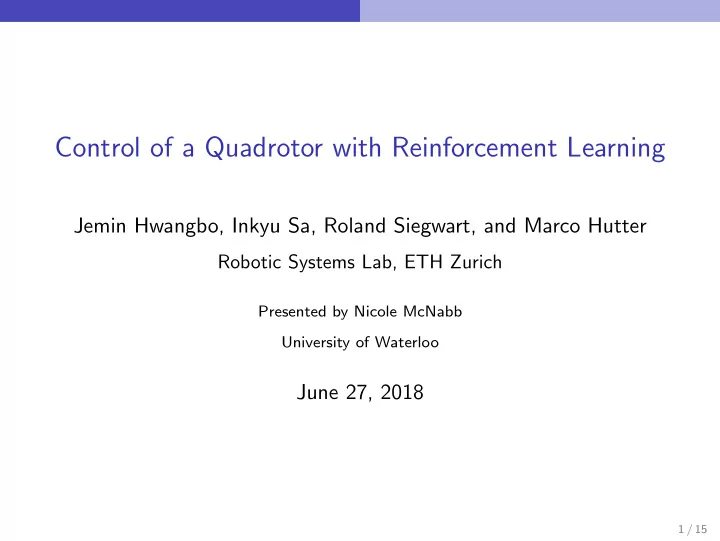

Control of a Quadrotor with Reinforcement Learning Jemin Hwangbo, Inkyu Sa, Roland Siegwart, and Marco Hutter Robotic Systems Lab, ETH Zurich Presented by Nicole McNabb University of Waterloo June 27, 2018 1 / 15
Overview Introduction 1 The Method 2 Empirical Results 3 Summary and Future Work 4 2 / 15
Introduction What is a quadrotor? Figure: Quadrotor [1] 3 / 15
Introduction What is a quadrotor? High-level goal: Train the quadrotor to perform tasks with varying initializations A policy optimization problem. Figure: Quadrotor [1] 4 / 15
Introduction Related Approaches Deep Deterministic Policy Trust Region Policy Optimization Gradient (DDPG) (TRPO) Actor-critic architecture Actor-critic architecture Off-policy, model-free Off-policy, model-free Deterministic Stochastic Insufficient exploration Computationally intensive Very slow (if any) Slow, unreliable convergence convergence 5 / 15
Introduction A New Approach Goal: A deterministic model with Fast and stable convergence Model-free training Extensive exploration Solution: A method combining the actor-critic architecture with an on-policy deterministic policy gradient algorithm and a new exploration strategy. 6 / 15
The Method Setup Continuous State-Action Space State Space 18-D states, model: Orientation (or rotation) Position Linear velocity of system Angular velocity of system Action Space 4-D actions, dictate rotor thrust for each rotor 7 / 15
The Method Exploration Figure: Exploration Strategy [2] 8 / 15
The Method Network Training Figure: Value Network [2] Figure: Policy Network [2] Value function training: Policy optimization: Approximate with Monte-Carlo Same idea as TRPO, replacing samples obtained from current KL-divergence with Mahalanobis trajectory metric 9 / 15
The Method Learning Algorithm Algorithm 1 Policy optimization 1: Input: Initial value function approximation, initial policy 2: for j = 1,2,. . . do Perform exploration, take action 3: Compute MC estimates from current trajectory 4: Do approximate value function update 5: Do policy gradient update 6: 7: end for 10 / 15
Empirical Results Empirical Results Training done in simulation Testing on two main tasks done on a real quadrotor 11 / 15
Summary and Future Work Summary Primary contributions: A new deterministic, model-free neural network policy for training a quadrotor Stable and reliable performance on hard tasks, even under harsh initial conditions 12 / 15
Summary and Future Work Future Research Also compare model against PPO Introducing more accurate model of the system into simulation Train an RNN to adapt to model errors automatically 13 / 15
Summary and Future Work References https://www.seeedstudio.com/Crazyflie-2.0-p-2103.html Jemin Hwangbo, Inkyu Sa, Roland Siegwart, and Marco Hutter Control of a Quadrotor with Reinforcement Learning IEEE Robotics and Automation Letters , June 2017. 14 / 15
Summary and Future Work Questions? 15 / 15
Recommend
More recommend